NUR1201: Enhancing Patient Experience Through Theory Application
VerifiedAdded on 2023/06/07
|18
|5522
|72
Essay
AI Summary
This essay provides an analysis of a patient experience case scenario, drawing upon relevant nursing theories such as Erik Erikson's theory of psychological development, to identify areas of ineffective and effective care. It emphasizes the importance of cultural competence and effective communication in nursing practice. The essay explores how partnering in care strategies, grounded in these theories, can enhance the patient experience, particularly for Aboriginal women. It discusses the application of the Erikson's Development Theory, highlighting both its positive aspects, such as increased nurse sensitivity, and potential drawbacks, like time consumption. The analysis underscores the need for culturally sensitive, interdisciplinary care to improve patient outcomes and overall healthcare delivery.
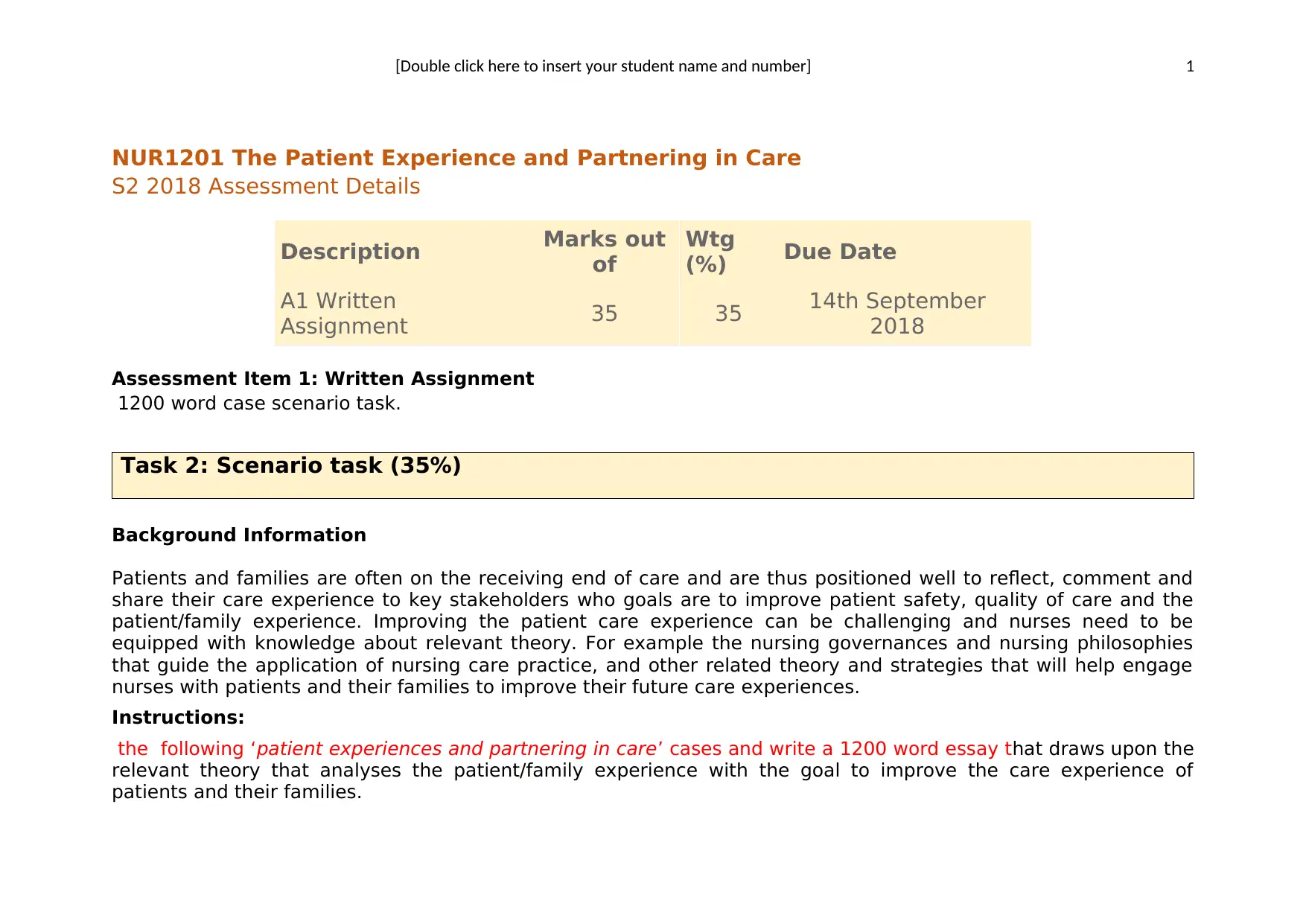
[Double click here to insert your student name and number] 1
NUR1201 The Patient Experience and Partnering in Care
S2 2018 Assessment Details
Description Marks out
of
Wtg
(%) Due Date
A1 Written
Assignment 35 35 14th September
2018
Assessment Item 1: Written Assignment
1200 word case scenario task.
Task 2: Scenario task (35%)
Background Information
Patients and families are often on the receiving end of care and are thus positioned well to reflect, comment and
share their care experience to key stakeholders who goals are to improve patient safety, quality of care and the
patient/family experience. Improving the patient care experience can be challenging and nurses need to be
equipped with knowledge about relevant theory. For example the nursing governances and nursing philosophies
that guide the application of nursing care practice, and other related theory and strategies that will help engage
nurses with patients and their families to improve their future care experiences.
Instructions:
the following ‘patient experiences and partnering in care’ cases and write a 1200 word essay that draws upon the
relevant theory that analyses the patient/family experience with the goal to improve the care experience of
patients and their families.
NUR1201 The Patient Experience and Partnering in Care
S2 2018 Assessment Details
Description Marks out
of
Wtg
(%) Due Date
A1 Written
Assignment 35 35 14th September
2018
Assessment Item 1: Written Assignment
1200 word case scenario task.
Task 2: Scenario task (35%)
Background Information
Patients and families are often on the receiving end of care and are thus positioned well to reflect, comment and
share their care experience to key stakeholders who goals are to improve patient safety, quality of care and the
patient/family experience. Improving the patient care experience can be challenging and nurses need to be
equipped with knowledge about relevant theory. For example the nursing governances and nursing philosophies
that guide the application of nursing care practice, and other related theory and strategies that will help engage
nurses with patients and their families to improve their future care experiences.
Instructions:
the following ‘patient experiences and partnering in care’ cases and write a 1200 word essay that draws upon the
relevant theory that analyses the patient/family experience with the goal to improve the care experience of
patients and their families.
Paraphrase This Document
Need a fresh take? Get an instant paraphrase of this document with our AI Paraphraser
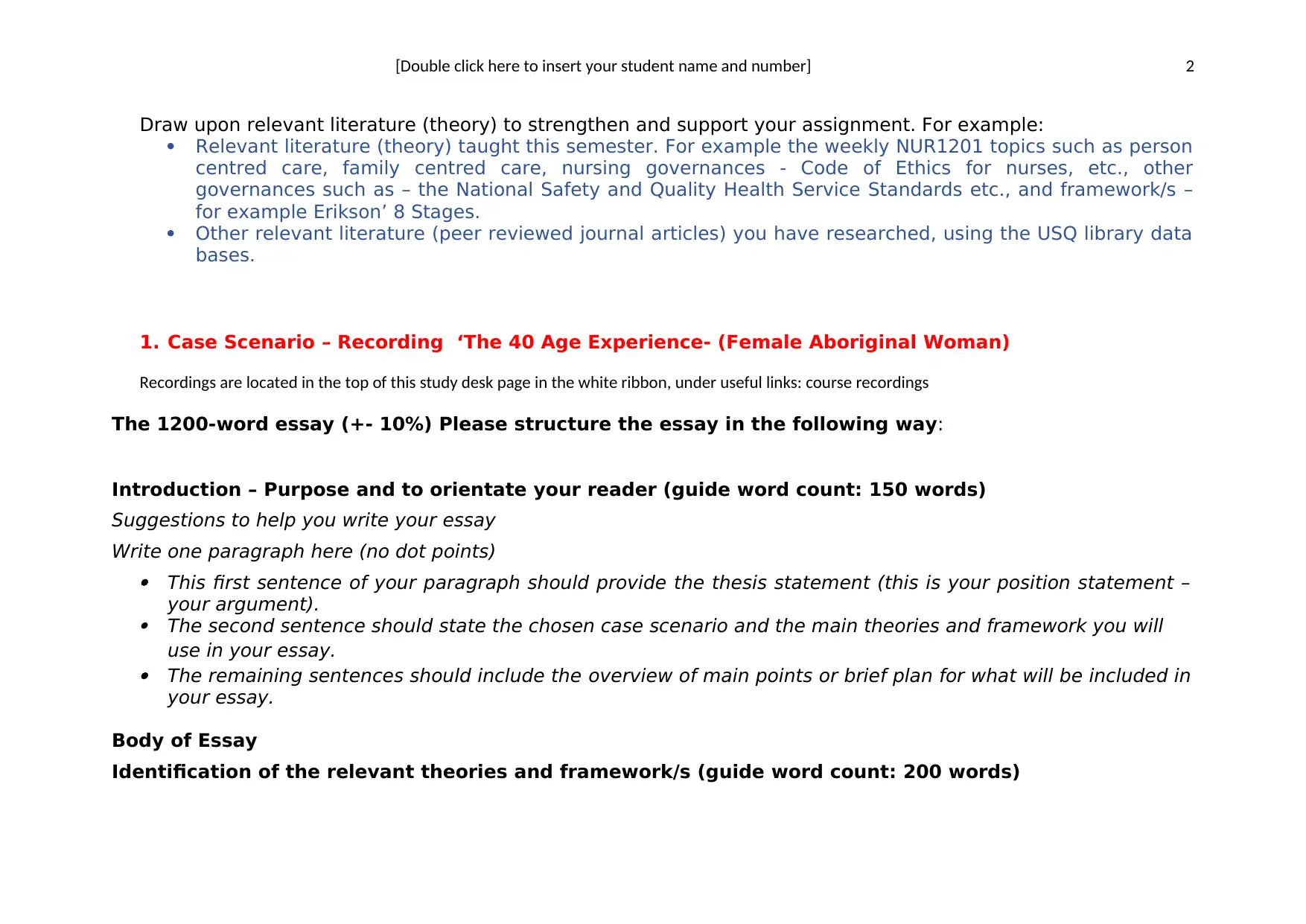
[Double click here to insert your student name and number] 2
Draw upon relevant literature (theory) to strengthen and support your assignment. For example:
Relevant literature (theory) taught this semester. For example the weekly NUR1201 topics such as person
centred care, family centred care, nursing governances - Code of Ethics for nurses, etc., other
governances such as – the National Safety and Quality Health Service Standards etc., and framework/s –
for example Erikson’ 8 Stages.
Other relevant literature (peer reviewed journal articles) you have researched, using the USQ library data
bases.
1. Case Scenario – Recording ‘The 40 Age Experience- (Female Aboriginal Woman)
Recordings are located in the top of this study desk page in the white ribbon, under useful links: course recordings
The 1200-word essay (+- 10%) Please structure the essay in the following way:
Introduction – Purpose and to orientate your reader (guide word count: 150 words)
Suggestions to help you write your essay
Write one paragraph here (no dot points) This first sentence of your paragraph should provide the thesis statement (this is your position statement –
your argument).
The second sentence should state the chosen case scenario and the main theories and framework you will
use in your essay.
The remaining sentences should include the overview of main points or brief plan for what will be included in
your essay.
Body of Essay
Identification of the relevant theories and framework/s (guide word count: 200 words)
Draw upon relevant literature (theory) to strengthen and support your assignment. For example:
Relevant literature (theory) taught this semester. For example the weekly NUR1201 topics such as person
centred care, family centred care, nursing governances - Code of Ethics for nurses, etc., other
governances such as – the National Safety and Quality Health Service Standards etc., and framework/s –
for example Erikson’ 8 Stages.
Other relevant literature (peer reviewed journal articles) you have researched, using the USQ library data
bases.
1. Case Scenario – Recording ‘The 40 Age Experience- (Female Aboriginal Woman)
Recordings are located in the top of this study desk page in the white ribbon, under useful links: course recordings
The 1200-word essay (+- 10%) Please structure the essay in the following way:
Introduction – Purpose and to orientate your reader (guide word count: 150 words)
Suggestions to help you write your essay
Write one paragraph here (no dot points) This first sentence of your paragraph should provide the thesis statement (this is your position statement –
your argument).
The second sentence should state the chosen case scenario and the main theories and framework you will
use in your essay.
The remaining sentences should include the overview of main points or brief plan for what will be included in
your essay.
Body of Essay
Identification of the relevant theories and framework/s (guide word count: 200 words)
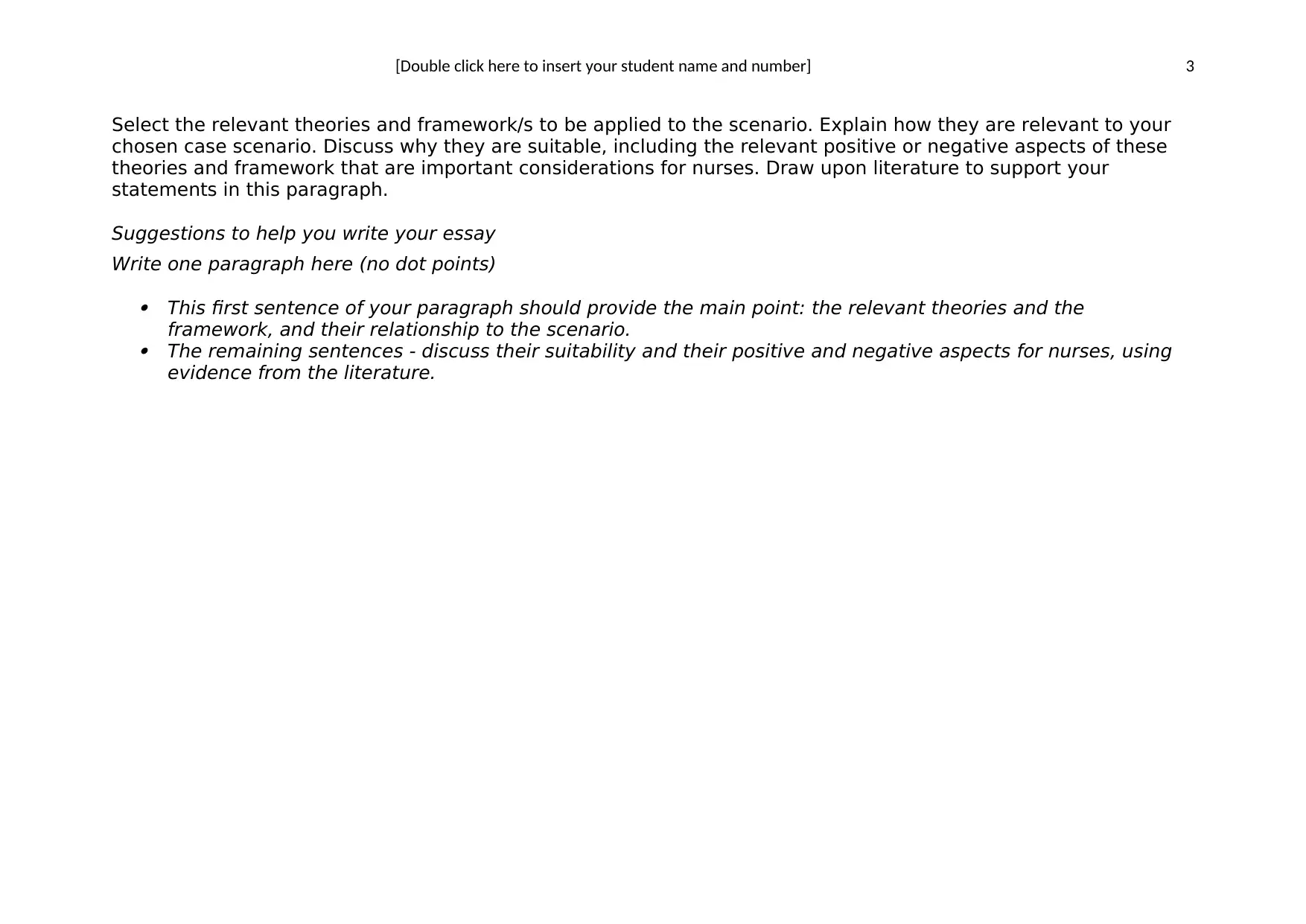
[Double click here to insert your student name and number] 3
Select the relevant theories and framework/s to be applied to the scenario. Explain how they are relevant to your
chosen case scenario. Discuss why they are suitable, including the relevant positive or negative aspects of these
theories and framework that are important considerations for nurses. Draw upon literature to support your
statements in this paragraph.
Suggestions to help you write your essay
Write one paragraph here (no dot points) This first sentence of your paragraph should provide the main point: the relevant theories and the
framework, and their relationship to the scenario.
The remaining sentences - discuss their suitability and their positive and negative aspects for nurses, using
evidence from the literature.
Select the relevant theories and framework/s to be applied to the scenario. Explain how they are relevant to your
chosen case scenario. Discuss why they are suitable, including the relevant positive or negative aspects of these
theories and framework that are important considerations for nurses. Draw upon literature to support your
statements in this paragraph.
Suggestions to help you write your essay
Write one paragraph here (no dot points) This first sentence of your paragraph should provide the main point: the relevant theories and the
framework, and their relationship to the scenario.
The remaining sentences - discuss their suitability and their positive and negative aspects for nurses, using
evidence from the literature.
⊘ This is a preview!⊘
Do you want full access?
Subscribe today to unlock all pages.

Trusted by 1+ million students worldwide
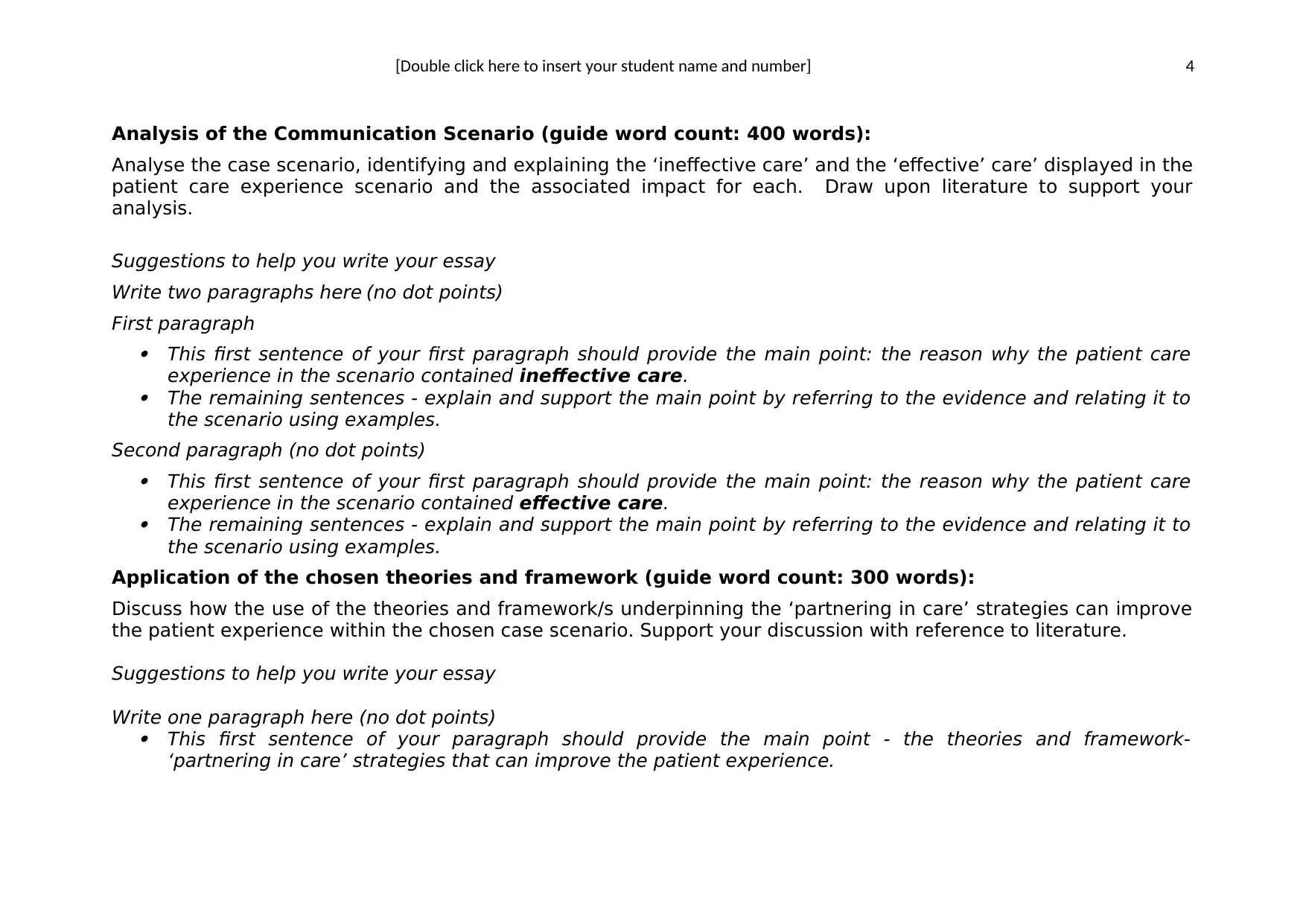
[Double click here to insert your student name and number] 4
Analysis of the Communication Scenario (guide word count: 400 words):
Analyse the case scenario, identifying and explaining the ‘ineffective care’ and the ‘effective’ care’ displayed in the
patient care experience scenario and the associated impact for each. Draw upon literature to support your
analysis.
Suggestions to help you write your essay
Write two paragraphs here (no dot points)
First paragraph This first sentence of your first paragraph should provide the main point: the reason why the patient care
experience in the scenario contained ineffective care.
The remaining sentences - explain and support the main point by referring to the evidence and relating it to
the scenario using examples.
Second paragraph (no dot points) This first sentence of your first paragraph should provide the main point: the reason why the patient care
experience in the scenario contained effective care.
The remaining sentences - explain and support the main point by referring to the evidence and relating it to
the scenario using examples.
Application of the chosen theories and framework (guide word count: 300 words):
Discuss how the use of the theories and framework/s underpinning the ‘partnering in care’ strategies can improve
the patient experience within the chosen case scenario. Support your discussion with reference to literature.
Suggestions to help you write your essay
Write one paragraph here (no dot points)
This first sentence of your paragraph should provide the main point - the theories and framework-
‘partnering in care’ strategies that can improve the patient experience.
Analysis of the Communication Scenario (guide word count: 400 words):
Analyse the case scenario, identifying and explaining the ‘ineffective care’ and the ‘effective’ care’ displayed in the
patient care experience scenario and the associated impact for each. Draw upon literature to support your
analysis.
Suggestions to help you write your essay
Write two paragraphs here (no dot points)
First paragraph This first sentence of your first paragraph should provide the main point: the reason why the patient care
experience in the scenario contained ineffective care.
The remaining sentences - explain and support the main point by referring to the evidence and relating it to
the scenario using examples.
Second paragraph (no dot points) This first sentence of your first paragraph should provide the main point: the reason why the patient care
experience in the scenario contained effective care.
The remaining sentences - explain and support the main point by referring to the evidence and relating it to
the scenario using examples.
Application of the chosen theories and framework (guide word count: 300 words):
Discuss how the use of the theories and framework/s underpinning the ‘partnering in care’ strategies can improve
the patient experience within the chosen case scenario. Support your discussion with reference to literature.
Suggestions to help you write your essay
Write one paragraph here (no dot points)
This first sentence of your paragraph should provide the main point - the theories and framework-
‘partnering in care’ strategies that can improve the patient experience.
Paraphrase This Document
Need a fresh take? Get an instant paraphrase of this document with our AI Paraphraser
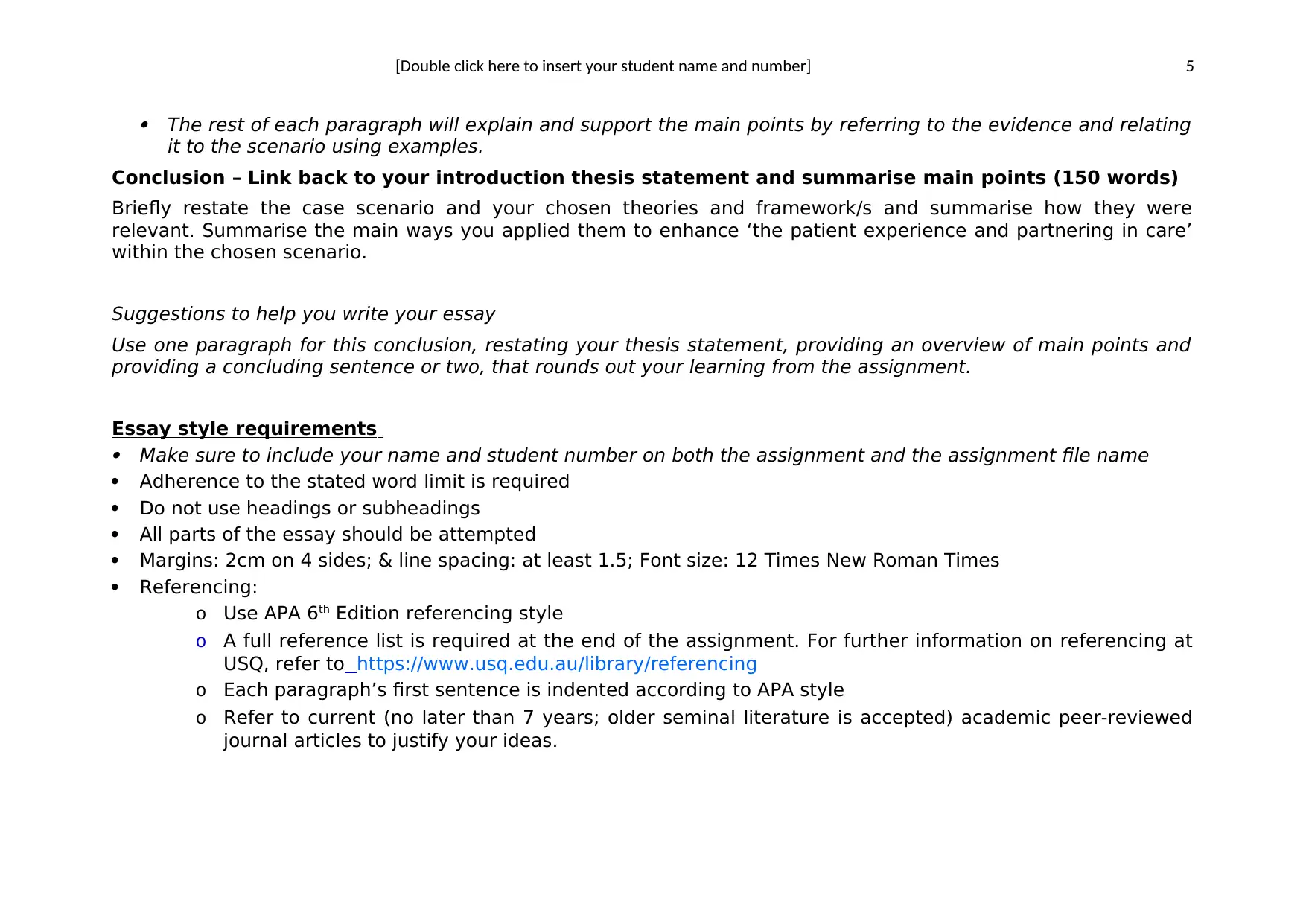
[Double click here to insert your student name and number] 5
The rest of each paragraph will explain and support the main points by referring to the evidence and relating
it to the scenario using examples.
Conclusion – Link back to your introduction thesis statement and summarise main points (150 words)
Briefly restate the case scenario and your chosen theories and framework/s and summarise how they were
relevant. Summarise the main ways you applied them to enhance ‘the patient experience and partnering in care’
within the chosen scenario.
Suggestions to help you write your essay
Use one paragraph for this conclusion, restating your thesis statement, providing an overview of main points and
providing a concluding sentence or two, that rounds out your learning from the assignment.
Essay style requirements Make sure to include your name and student number on both the assignment and the assignment file name
Adherence to the stated word limit is required
Do not use headings or subheadings
All parts of the essay should be attempted
Margins: 2cm on 4 sides; & line spacing: at least 1.5; Font size: 12 Times New Roman Times
Referencing:
o Use APA 6th Edition referencing style
o A full reference list is required at the end of the assignment. For further information on referencing at
USQ, refer to https://www.usq.edu.au/library/referencing
o Each paragraph’s first sentence is indented according to APA style
o Refer to current (no later than 7 years; older seminal literature is accepted) academic peer-reviewed
journal articles to justify your ideas.
The rest of each paragraph will explain and support the main points by referring to the evidence and relating
it to the scenario using examples.
Conclusion – Link back to your introduction thesis statement and summarise main points (150 words)
Briefly restate the case scenario and your chosen theories and framework/s and summarise how they were
relevant. Summarise the main ways you applied them to enhance ‘the patient experience and partnering in care’
within the chosen scenario.
Suggestions to help you write your essay
Use one paragraph for this conclusion, restating your thesis statement, providing an overview of main points and
providing a concluding sentence or two, that rounds out your learning from the assignment.
Essay style requirements Make sure to include your name and student number on both the assignment and the assignment file name
Adherence to the stated word limit is required
Do not use headings or subheadings
All parts of the essay should be attempted
Margins: 2cm on 4 sides; & line spacing: at least 1.5; Font size: 12 Times New Roman Times
Referencing:
o Use APA 6th Edition referencing style
o A full reference list is required at the end of the assignment. For further information on referencing at
USQ, refer to https://www.usq.edu.au/library/referencing
o Each paragraph’s first sentence is indented according to APA style
o Refer to current (no later than 7 years; older seminal literature is accepted) academic peer-reviewed
journal articles to justify your ideas.
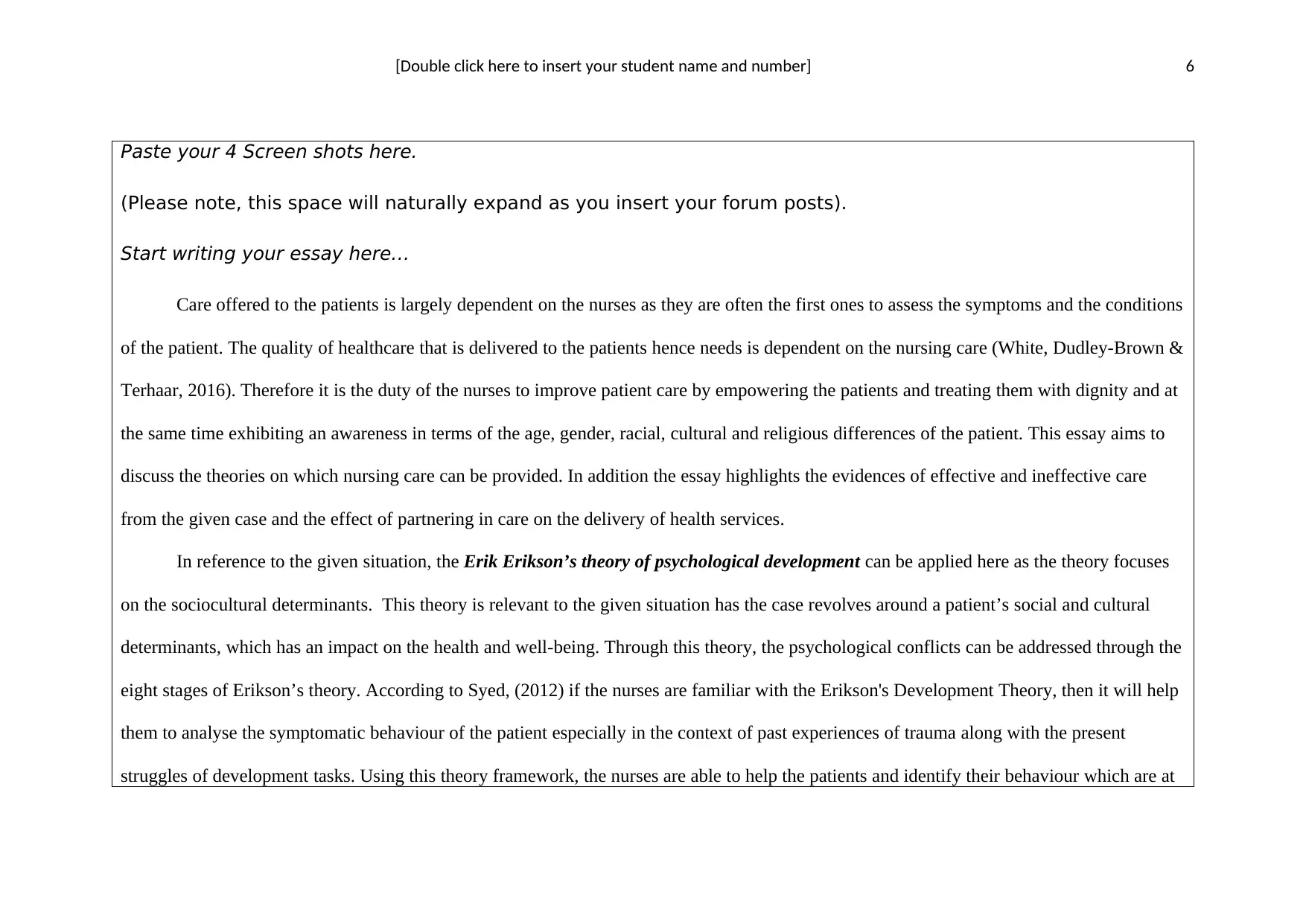
[Double click here to insert your student name and number] 6
Paste your 4 Screen shots here.
(Please note, this space will naturally expand as you insert your forum posts).
Start writing your essay here…
Care offered to the patients is largely dependent on the nurses as they are often the first ones to assess the symptoms and the conditions
of the patient. The quality of healthcare that is delivered to the patients hence needs is dependent on the nursing care (White, Dudley-Brown &
Terhaar, 2016). Therefore it is the duty of the nurses to improve patient care by empowering the patients and treating them with dignity and at
the same time exhibiting an awareness in terms of the age, gender, racial, cultural and religious differences of the patient. This essay aims to
discuss the theories on which nursing care can be provided. In addition the essay highlights the evidences of effective and ineffective care
from the given case and the effect of partnering in care on the delivery of health services.
In reference to the given situation, the Erik Erikson’s theory of psychological development can be applied here as the theory focuses
on the sociocultural determinants. This theory is relevant to the given situation has the case revolves around a patient’s social and cultural
determinants, which has an impact on the health and well-being. Through this theory, the psychological conflicts can be addressed through the
eight stages of Erikson’s theory. According to Syed, (2012) if the nurses are familiar with the Erikson's Development Theory, then it will help
them to analyse the symptomatic behaviour of the patient especially in the context of past experiences of trauma along with the present
struggles of development tasks. Using this theory framework, the nurses are able to help the patients and identify their behaviour which are at
Paste your 4 Screen shots here.
(Please note, this space will naturally expand as you insert your forum posts).
Start writing your essay here…
Care offered to the patients is largely dependent on the nurses as they are often the first ones to assess the symptoms and the conditions
of the patient. The quality of healthcare that is delivered to the patients hence needs is dependent on the nursing care (White, Dudley-Brown &
Terhaar, 2016). Therefore it is the duty of the nurses to improve patient care by empowering the patients and treating them with dignity and at
the same time exhibiting an awareness in terms of the age, gender, racial, cultural and religious differences of the patient. This essay aims to
discuss the theories on which nursing care can be provided. In addition the essay highlights the evidences of effective and ineffective care
from the given case and the effect of partnering in care on the delivery of health services.
In reference to the given situation, the Erik Erikson’s theory of psychological development can be applied here as the theory focuses
on the sociocultural determinants. This theory is relevant to the given situation has the case revolves around a patient’s social and cultural
determinants, which has an impact on the health and well-being. Through this theory, the psychological conflicts can be addressed through the
eight stages of Erikson’s theory. According to Syed, (2012) if the nurses are familiar with the Erikson's Development Theory, then it will help
them to analyse the symptomatic behaviour of the patient especially in the context of past experiences of trauma along with the present
struggles of development tasks. Using this theory framework, the nurses are able to help the patients and identify their behaviour which are at
⊘ This is a preview!⊘
Do you want full access?
Subscribe today to unlock all pages.

Trusted by 1+ million students worldwide
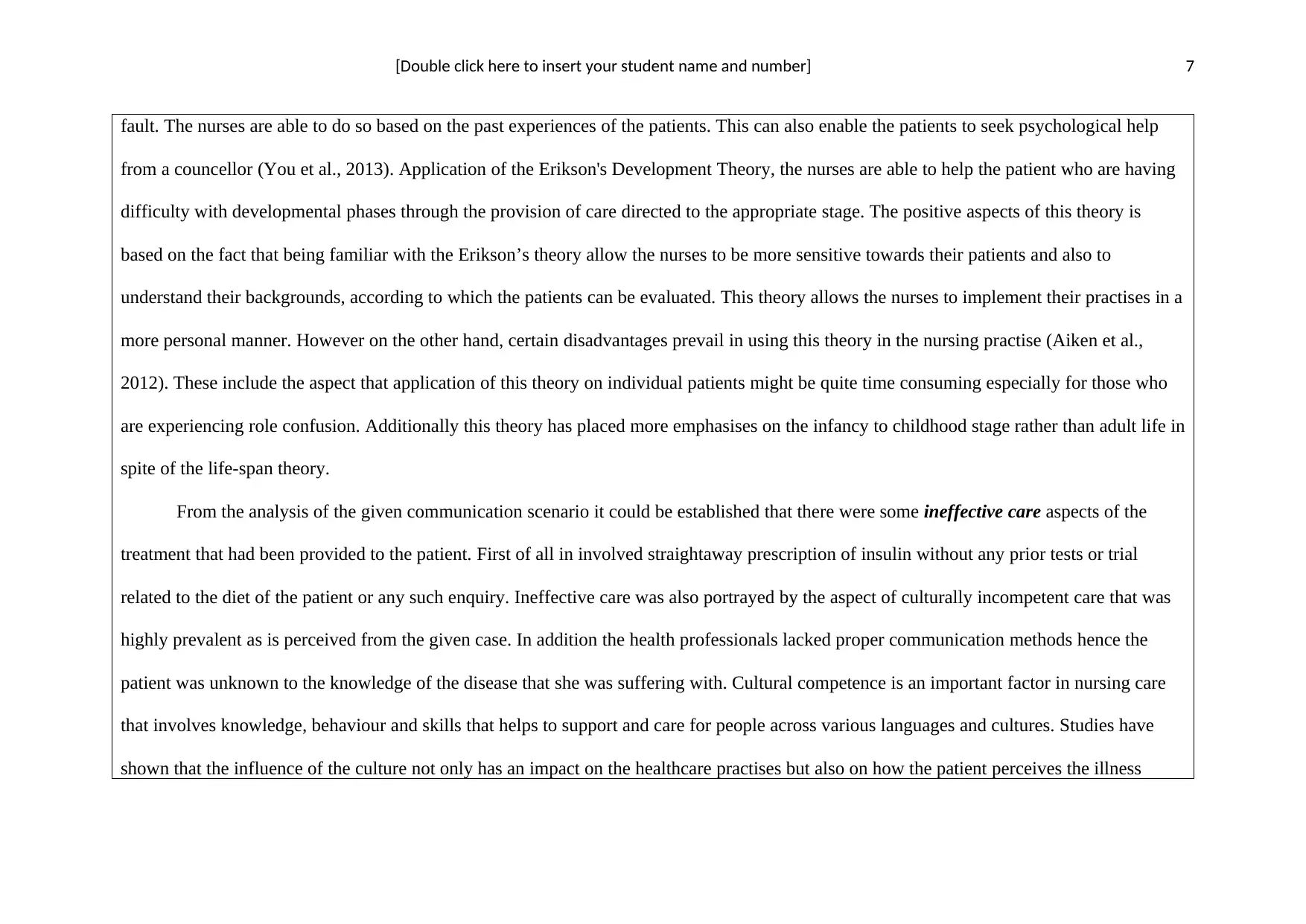
[Double click here to insert your student name and number] 7
fault. The nurses are able to do so based on the past experiences of the patients. This can also enable the patients to seek psychological help
from a councellor (You et al., 2013). Application of the Erikson's Development Theory, the nurses are able to help the patient who are having
difficulty with developmental phases through the provision of care directed to the appropriate stage. The positive aspects of this theory is
based on the fact that being familiar with the Erikson’s theory allow the nurses to be more sensitive towards their patients and also to
understand their backgrounds, according to which the patients can be evaluated. This theory allows the nurses to implement their practises in a
more personal manner. However on the other hand, certain disadvantages prevail in using this theory in the nursing practise (Aiken et al.,
2012). These include the aspect that application of this theory on individual patients might be quite time consuming especially for those who
are experiencing role confusion. Additionally this theory has placed more emphasises on the infancy to childhood stage rather than adult life in
spite of the life-span theory.
From the analysis of the given communication scenario it could be established that there were some ineffective care aspects of the
treatment that had been provided to the patient. First of all in involved straightaway prescription of insulin without any prior tests or trial
related to the diet of the patient or any such enquiry. Ineffective care was also portrayed by the aspect of culturally incompetent care that was
highly prevalent as is perceived from the given case. In addition the health professionals lacked proper communication methods hence the
patient was unknown to the knowledge of the disease that she was suffering with. Cultural competence is an important factor in nursing care
that involves knowledge, behaviour and skills that helps to support and care for people across various languages and cultures. Studies have
shown that the influence of the culture not only has an impact on the healthcare practises but also on how the patient perceives the illness
fault. The nurses are able to do so based on the past experiences of the patients. This can also enable the patients to seek psychological help
from a councellor (You et al., 2013). Application of the Erikson's Development Theory, the nurses are able to help the patient who are having
difficulty with developmental phases through the provision of care directed to the appropriate stage. The positive aspects of this theory is
based on the fact that being familiar with the Erikson’s theory allow the nurses to be more sensitive towards their patients and also to
understand their backgrounds, according to which the patients can be evaluated. This theory allows the nurses to implement their practises in a
more personal manner. However on the other hand, certain disadvantages prevail in using this theory in the nursing practise (Aiken et al.,
2012). These include the aspect that application of this theory on individual patients might be quite time consuming especially for those who
are experiencing role confusion. Additionally this theory has placed more emphasises on the infancy to childhood stage rather than adult life in
spite of the life-span theory.
From the analysis of the given communication scenario it could be established that there were some ineffective care aspects of the
treatment that had been provided to the patient. First of all in involved straightaway prescription of insulin without any prior tests or trial
related to the diet of the patient or any such enquiry. Ineffective care was also portrayed by the aspect of culturally incompetent care that was
highly prevalent as is perceived from the given case. In addition the health professionals lacked proper communication methods hence the
patient was unknown to the knowledge of the disease that she was suffering with. Cultural competence is an important factor in nursing care
that involves knowledge, behaviour and skills that helps to support and care for people across various languages and cultures. Studies have
shown that the influence of the culture not only has an impact on the healthcare practises but also on how the patient perceives the illness
Paraphrase This Document
Need a fresh take? Get an instant paraphrase of this document with our AI Paraphraser
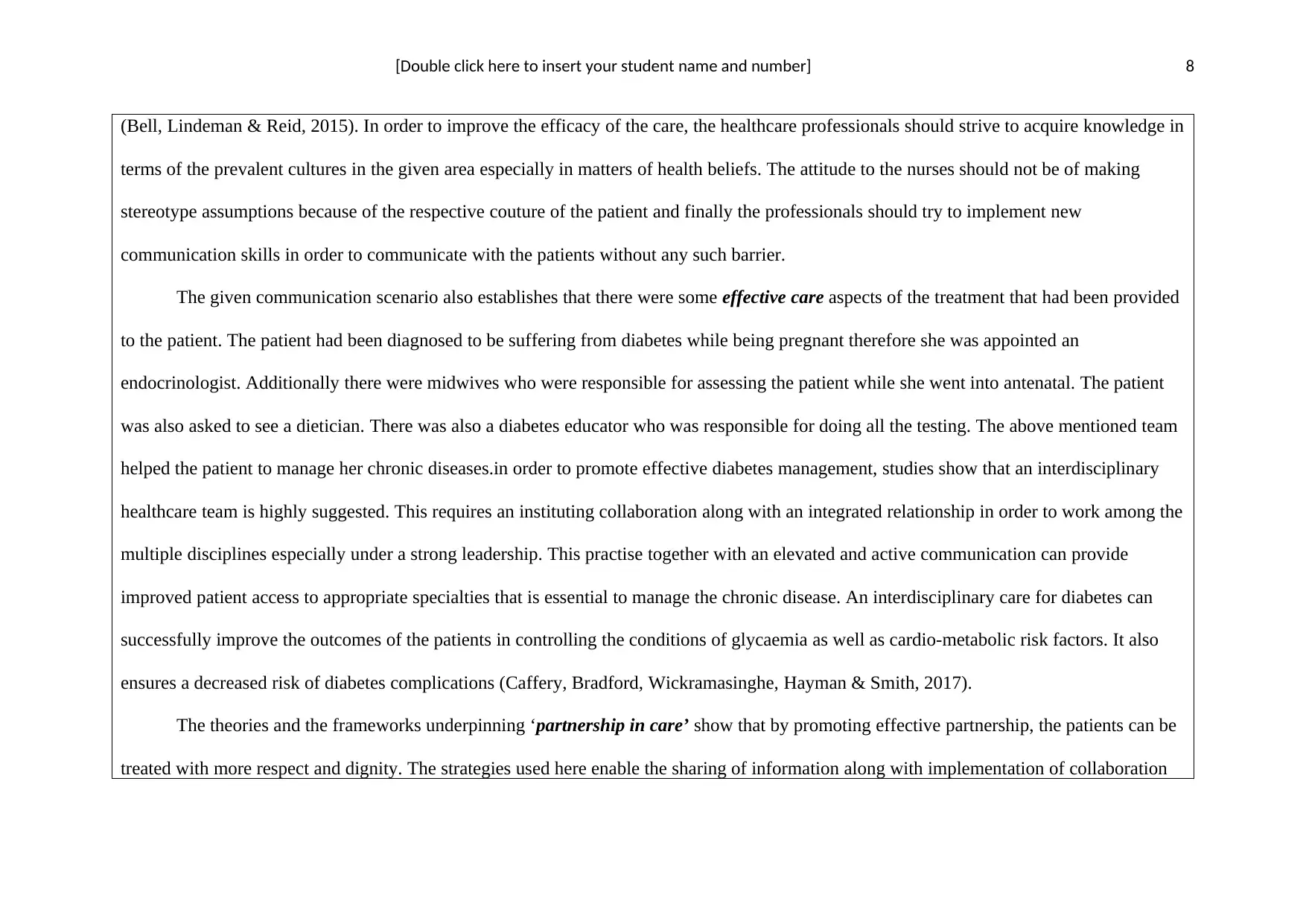
[Double click here to insert your student name and number] 8
(Bell, Lindeman & Reid, 2015). In order to improve the efficacy of the care, the healthcare professionals should strive to acquire knowledge in
terms of the prevalent cultures in the given area especially in matters of health beliefs. The attitude to the nurses should not be of making
stereotype assumptions because of the respective couture of the patient and finally the professionals should try to implement new
communication skills in order to communicate with the patients without any such barrier.
The given communication scenario also establishes that there were some effective care aspects of the treatment that had been provided
to the patient. The patient had been diagnosed to be suffering from diabetes while being pregnant therefore she was appointed an
endocrinologist. Additionally there were midwives who were responsible for assessing the patient while she went into antenatal. The patient
was also asked to see a dietician. There was also a diabetes educator who was responsible for doing all the testing. The above mentioned team
helped the patient to manage her chronic diseases.in order to promote effective diabetes management, studies show that an interdisciplinary
healthcare team is highly suggested. This requires an instituting collaboration along with an integrated relationship in order to work among the
multiple disciplines especially under a strong leadership. This practise together with an elevated and active communication can provide
improved patient access to appropriate specialties that is essential to manage the chronic disease. An interdisciplinary care for diabetes can
successfully improve the outcomes of the patients in controlling the conditions of glycaemia as well as cardio-metabolic risk factors. It also
ensures a decreased risk of diabetes complications (Caffery, Bradford, Wickramasinghe, Hayman & Smith, 2017).
The theories and the frameworks underpinning ‘partnership in care’ show that by promoting effective partnership, the patients can be
treated with more respect and dignity. The strategies used here enable the sharing of information along with implementation of collaboration
(Bell, Lindeman & Reid, 2015). In order to improve the efficacy of the care, the healthcare professionals should strive to acquire knowledge in
terms of the prevalent cultures in the given area especially in matters of health beliefs. The attitude to the nurses should not be of making
stereotype assumptions because of the respective couture of the patient and finally the professionals should try to implement new
communication skills in order to communicate with the patients without any such barrier.
The given communication scenario also establishes that there were some effective care aspects of the treatment that had been provided
to the patient. The patient had been diagnosed to be suffering from diabetes while being pregnant therefore she was appointed an
endocrinologist. Additionally there were midwives who were responsible for assessing the patient while she went into antenatal. The patient
was also asked to see a dietician. There was also a diabetes educator who was responsible for doing all the testing. The above mentioned team
helped the patient to manage her chronic diseases.in order to promote effective diabetes management, studies show that an interdisciplinary
healthcare team is highly suggested. This requires an instituting collaboration along with an integrated relationship in order to work among the
multiple disciplines especially under a strong leadership. This practise together with an elevated and active communication can provide
improved patient access to appropriate specialties that is essential to manage the chronic disease. An interdisciplinary care for diabetes can
successfully improve the outcomes of the patients in controlling the conditions of glycaemia as well as cardio-metabolic risk factors. It also
ensures a decreased risk of diabetes complications (Caffery, Bradford, Wickramasinghe, Hayman & Smith, 2017).
The theories and the frameworks underpinning ‘partnership in care’ show that by promoting effective partnership, the patients can be
treated with more respect and dignity. The strategies used here enable the sharing of information along with implementation of collaboration
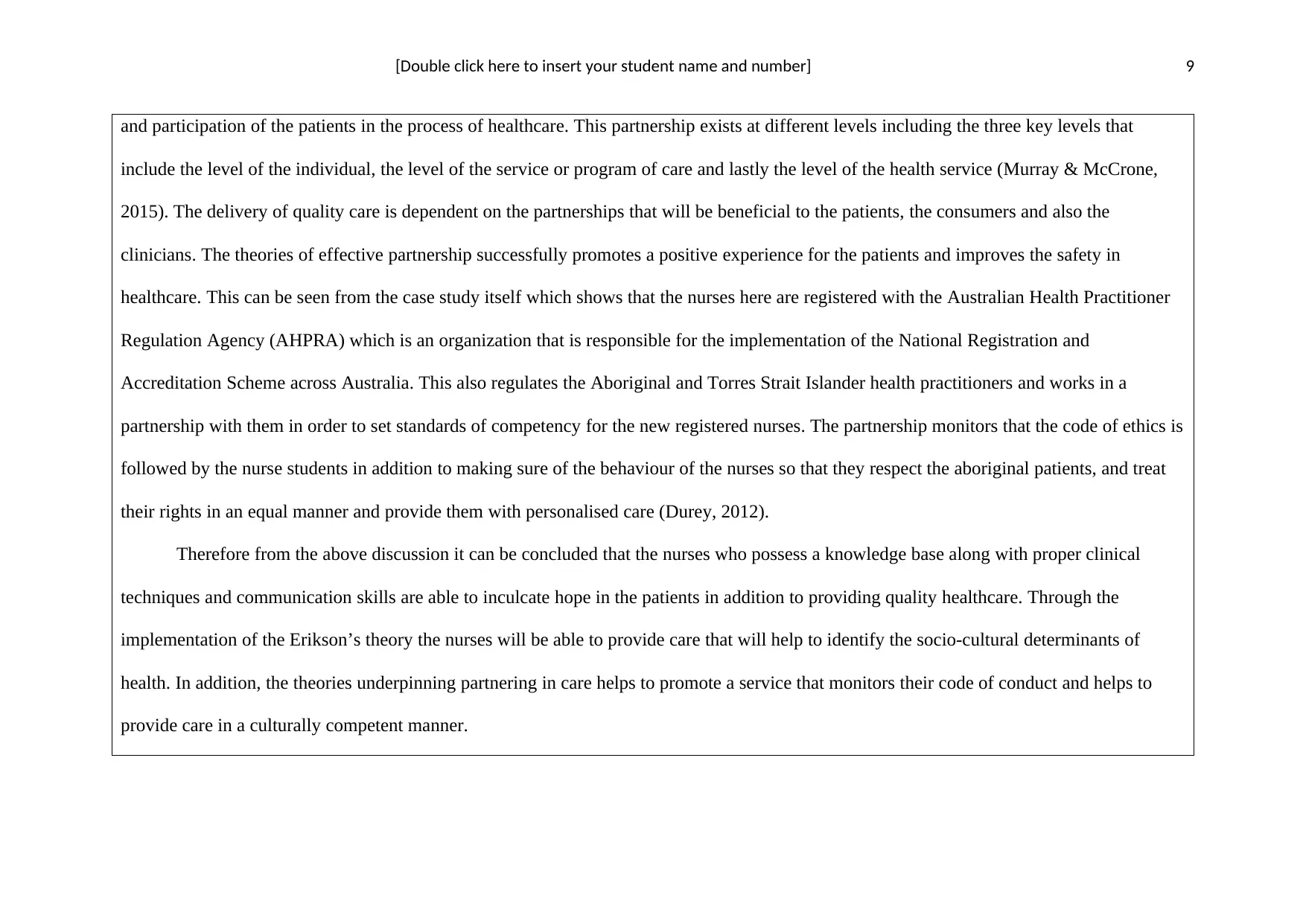
[Double click here to insert your student name and number] 9
and participation of the patients in the process of healthcare. This partnership exists at different levels including the three key levels that
include the level of the individual, the level of the service or program of care and lastly the level of the health service (Murray & McCrone,
2015). The delivery of quality care is dependent on the partnerships that will be beneficial to the patients, the consumers and also the
clinicians. The theories of effective partnership successfully promotes a positive experience for the patients and improves the safety in
healthcare. This can be seen from the case study itself which shows that the nurses here are registered with the Australian Health Practitioner
Regulation Agency (AHPRA) which is an organization that is responsible for the implementation of the National Registration and
Accreditation Scheme across Australia. This also regulates the Aboriginal and Torres Strait Islander health practitioners and works in a
partnership with them in order to set standards of competency for the new registered nurses. The partnership monitors that the code of ethics is
followed by the nurse students in addition to making sure of the behaviour of the nurses so that they respect the aboriginal patients, and treat
their rights in an equal manner and provide them with personalised care (Durey, 2012).
Therefore from the above discussion it can be concluded that the nurses who possess a knowledge base along with proper clinical
techniques and communication skills are able to inculcate hope in the patients in addition to providing quality healthcare. Through the
implementation of the Erikson’s theory the nurses will be able to provide care that will help to identify the socio-cultural determinants of
health. In addition, the theories underpinning partnering in care helps to promote a service that monitors their code of conduct and helps to
provide care in a culturally competent manner.
and participation of the patients in the process of healthcare. This partnership exists at different levels including the three key levels that
include the level of the individual, the level of the service or program of care and lastly the level of the health service (Murray & McCrone,
2015). The delivery of quality care is dependent on the partnerships that will be beneficial to the patients, the consumers and also the
clinicians. The theories of effective partnership successfully promotes a positive experience for the patients and improves the safety in
healthcare. This can be seen from the case study itself which shows that the nurses here are registered with the Australian Health Practitioner
Regulation Agency (AHPRA) which is an organization that is responsible for the implementation of the National Registration and
Accreditation Scheme across Australia. This also regulates the Aboriginal and Torres Strait Islander health practitioners and works in a
partnership with them in order to set standards of competency for the new registered nurses. The partnership monitors that the code of ethics is
followed by the nurse students in addition to making sure of the behaviour of the nurses so that they respect the aboriginal patients, and treat
their rights in an equal manner and provide them with personalised care (Durey, 2012).
Therefore from the above discussion it can be concluded that the nurses who possess a knowledge base along with proper clinical
techniques and communication skills are able to inculcate hope in the patients in addition to providing quality healthcare. Through the
implementation of the Erikson’s theory the nurses will be able to provide care that will help to identify the socio-cultural determinants of
health. In addition, the theories underpinning partnering in care helps to promote a service that monitors their code of conduct and helps to
provide care in a culturally competent manner.
⊘ This is a preview!⊘
Do you want full access?
Subscribe today to unlock all pages.

Trusted by 1+ million students worldwide
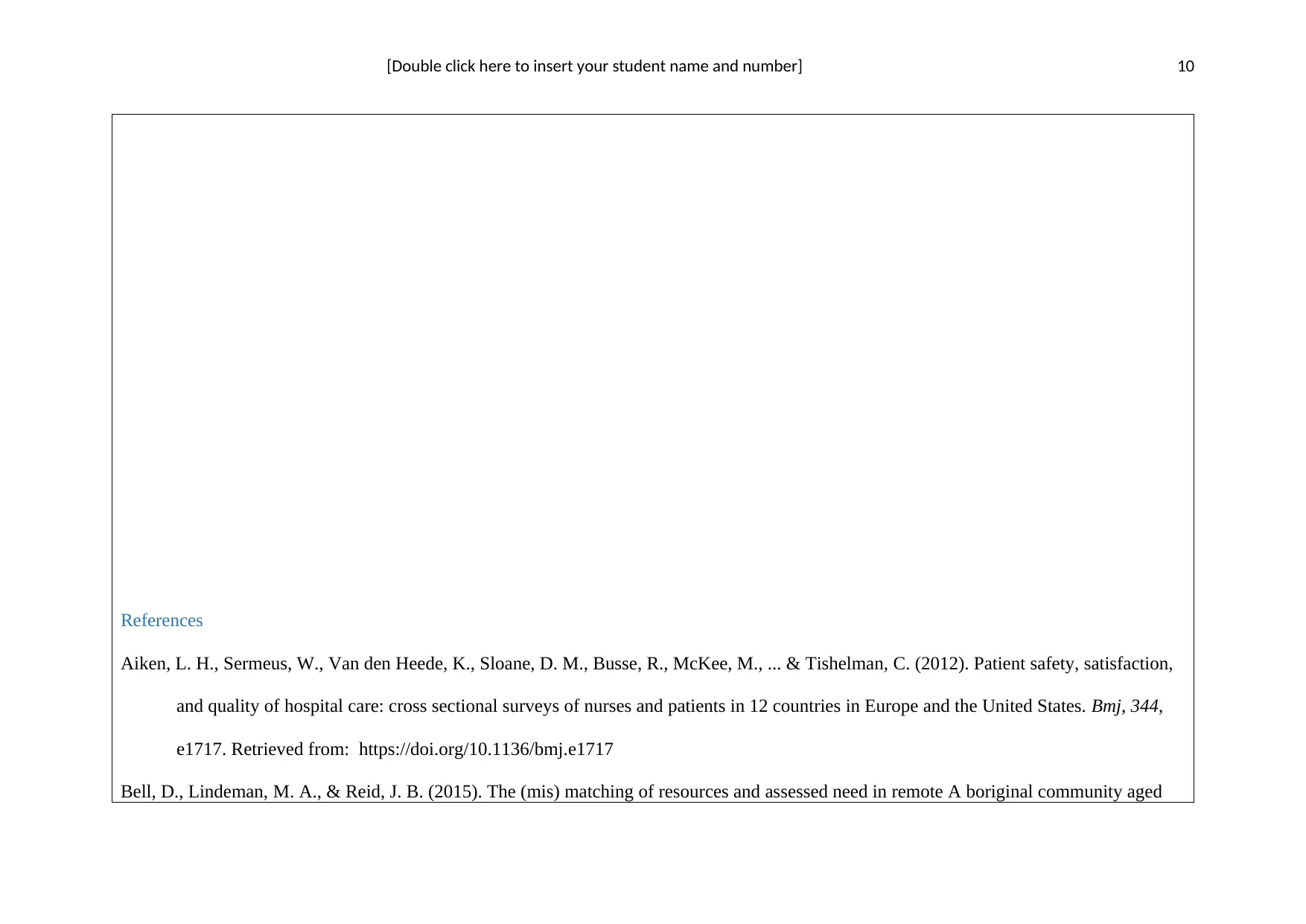
[Double click here to insert your student name and number] 10
References
Aiken, L. H., Sermeus, W., Van den Heede, K., Sloane, D. M., Busse, R., McKee, M., ... & Tishelman, C. (2012). Patient safety, satisfaction,
and quality of hospital care: cross sectional surveys of nurses and patients in 12 countries in Europe and the United States. Bmj, 344,
e1717. Retrieved from: https://doi.org/10.1136/bmj.e1717
Bell, D., Lindeman, M. A., & Reid, J. B. (2015). The (mis) matching of resources and assessed need in remote A boriginal community aged
References
Aiken, L. H., Sermeus, W., Van den Heede, K., Sloane, D. M., Busse, R., McKee, M., ... & Tishelman, C. (2012). Patient safety, satisfaction,
and quality of hospital care: cross sectional surveys of nurses and patients in 12 countries in Europe and the United States. Bmj, 344,
e1717. Retrieved from: https://doi.org/10.1136/bmj.e1717
Bell, D., Lindeman, M. A., & Reid, J. B. (2015). The (mis) matching of resources and assessed need in remote A boriginal community aged
Paraphrase This Document
Need a fresh take? Get an instant paraphrase of this document with our AI Paraphraser
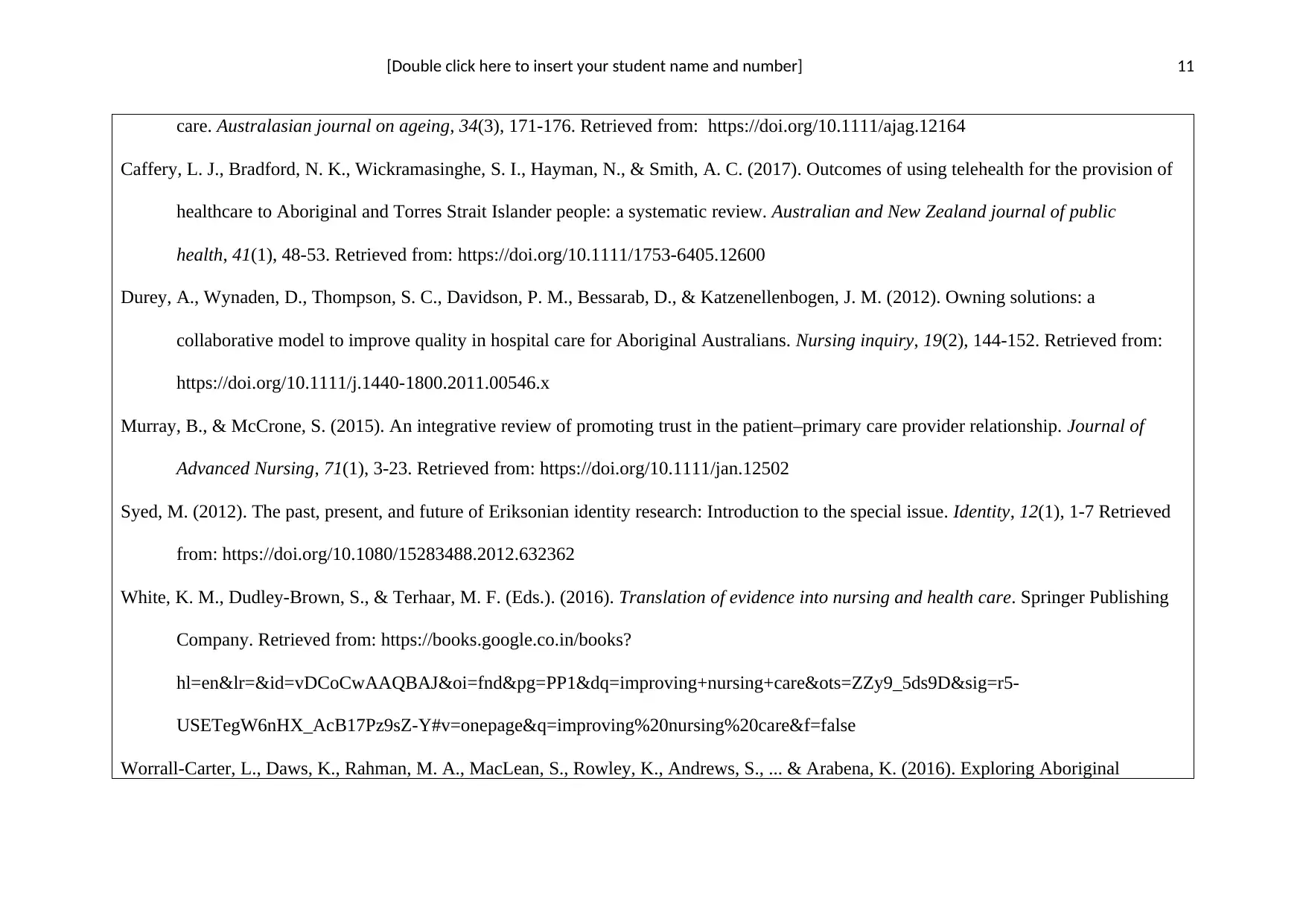
[Double click here to insert your student name and number] 11
care. Australasian journal on ageing, 34(3), 171-176. Retrieved from: https://doi.org/10.1111/ajag.12164
Caffery, L. J., Bradford, N. K., Wickramasinghe, S. I., Hayman, N., & Smith, A. C. (2017). Outcomes of using telehealth for the provision of
healthcare to Aboriginal and Torres Strait Islander people: a systematic review. Australian and New Zealand journal of public
health, 41(1), 48-53. Retrieved from: https://doi.org/10.1111/1753-6405.12600
Durey, A., Wynaden, D., Thompson, S. C., Davidson, P. M., Bessarab, D., & Katzenellenbogen, J. M. (2012). Owning solutions: a
collaborative model to improve quality in hospital care for Aboriginal Australians. Nursing inquiry, 19(2), 144-152. Retrieved from:
https://doi.org/10.1111/j.1440-1800.2011.00546.x
Murray, B., & McCrone, S. (2015). An integrative review of promoting trust in the patient–primary care provider relationship. Journal of
Advanced Nursing, 71(1), 3-23. Retrieved from: https://doi.org/10.1111/jan.12502
Syed, M. (2012). The past, present, and future of Eriksonian identity research: Introduction to the special issue. Identity, 12(1), 1-7 Retrieved
from: https://doi.org/10.1080/15283488.2012.632362
White, K. M., Dudley-Brown, S., & Terhaar, M. F. (Eds.). (2016). Translation of evidence into nursing and health care. Springer Publishing
Company. Retrieved from: https://books.google.co.in/books?
hl=en&lr=&id=vDCoCwAAQBAJ&oi=fnd&pg=PP1&dq=improving+nursing+care&ots=ZZy9_5ds9D&sig=r5-
USETegW6nHX_AcB17Pz9sZ-Y#v=onepage&q=improving%20nursing%20care&f=false
Worrall-Carter, L., Daws, K., Rahman, M. A., MacLean, S., Rowley, K., Andrews, S., ... & Arabena, K. (2016). Exploring Aboriginal
care. Australasian journal on ageing, 34(3), 171-176. Retrieved from: https://doi.org/10.1111/ajag.12164
Caffery, L. J., Bradford, N. K., Wickramasinghe, S. I., Hayman, N., & Smith, A. C. (2017). Outcomes of using telehealth for the provision of
healthcare to Aboriginal and Torres Strait Islander people: a systematic review. Australian and New Zealand journal of public
health, 41(1), 48-53. Retrieved from: https://doi.org/10.1111/1753-6405.12600
Durey, A., Wynaden, D., Thompson, S. C., Davidson, P. M., Bessarab, D., & Katzenellenbogen, J. M. (2012). Owning solutions: a
collaborative model to improve quality in hospital care for Aboriginal Australians. Nursing inquiry, 19(2), 144-152. Retrieved from:
https://doi.org/10.1111/j.1440-1800.2011.00546.x
Murray, B., & McCrone, S. (2015). An integrative review of promoting trust in the patient–primary care provider relationship. Journal of
Advanced Nursing, 71(1), 3-23. Retrieved from: https://doi.org/10.1111/jan.12502
Syed, M. (2012). The past, present, and future of Eriksonian identity research: Introduction to the special issue. Identity, 12(1), 1-7 Retrieved
from: https://doi.org/10.1080/15283488.2012.632362
White, K. M., Dudley-Brown, S., & Terhaar, M. F. (Eds.). (2016). Translation of evidence into nursing and health care. Springer Publishing
Company. Retrieved from: https://books.google.co.in/books?
hl=en&lr=&id=vDCoCwAAQBAJ&oi=fnd&pg=PP1&dq=improving+nursing+care&ots=ZZy9_5ds9D&sig=r5-
USETegW6nHX_AcB17Pz9sZ-Y#v=onepage&q=improving%20nursing%20care&f=false
Worrall-Carter, L., Daws, K., Rahman, M. A., MacLean, S., Rowley, K., Andrews, S., ... & Arabena, K. (2016). Exploring Aboriginal
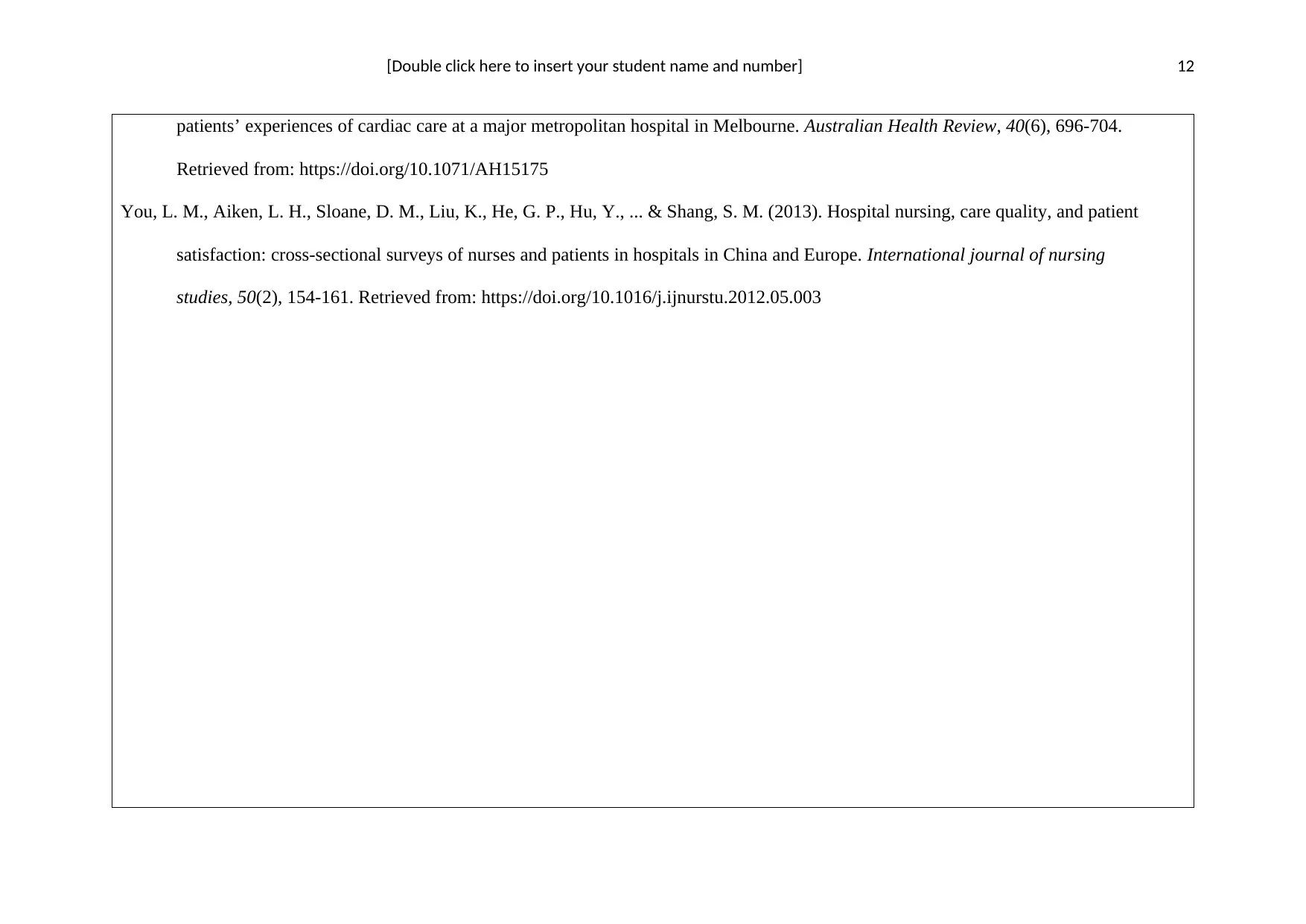
[Double click here to insert your student name and number] 12
patients’ experiences of cardiac care at a major metropolitan hospital in Melbourne. Australian Health Review, 40(6), 696-704.
Retrieved from: https://doi.org/10.1071/AH15175
You, L. M., Aiken, L. H., Sloane, D. M., Liu, K., He, G. P., Hu, Y., ... & Shang, S. M. (2013). Hospital nursing, care quality, and patient
satisfaction: cross-sectional surveys of nurses and patients in hospitals in China and Europe. International journal of nursing
studies, 50(2), 154-161. Retrieved from: https://doi.org/10.1016/j.ijnurstu.2012.05.003
patients’ experiences of cardiac care at a major metropolitan hospital in Melbourne. Australian Health Review, 40(6), 696-704.
Retrieved from: https://doi.org/10.1071/AH15175
You, L. M., Aiken, L. H., Sloane, D. M., Liu, K., He, G. P., Hu, Y., ... & Shang, S. M. (2013). Hospital nursing, care quality, and patient
satisfaction: cross-sectional surveys of nurses and patients in hospitals in China and Europe. International journal of nursing
studies, 50(2), 154-161. Retrieved from: https://doi.org/10.1016/j.ijnurstu.2012.05.003
⊘ This is a preview!⊘
Do you want full access?
Subscribe today to unlock all pages.

Trusted by 1+ million students worldwide
1 out of 18
Related Documents
Your All-in-One AI-Powered Toolkit for Academic Success.
+13062052269
info@desklib.com
Available 24*7 on WhatsApp / Email
![[object Object]](/_next/static/media/star-bottom.7253800d.svg)
Unlock your academic potential
Copyright © 2020–2025 A2Z Services. All Rights Reserved. Developed and managed by ZUCOL.





